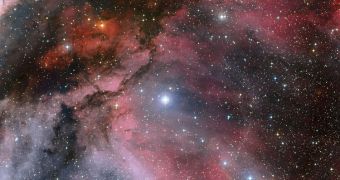Astronomers from the European Southern Observatory (ESO) announced that they used one of the organization's facilities to snap an incredibly-detailed view of the star WR 22. The brilliant and unusual cosmic fireball is surrounded by a peculiar cloud of matter, and the new photo also includes never-before-seen details of the area. The object can be seen in the Carina Nebula, a dramatic stellar nursery that produces atypical stars. WR 22 is currently located at the outer fringes of its home.
“Very massive stars live fast and die young. Some of these stellar beacons have such intense radiation passing through their thick atmospheres late in their lives that they shed material into space many millions of times more quickly than relatively sedate stars such as the Sun. These rare, very hot and massive objects are known as Wolf–Rayet stars, after the two French astronomers who first identified them in the mid-nineteenth century, and one of the most massive ones yet measured is known as WR 22,” ESO experts write in a press release accompanying the new image.
The photo was snapped from the La Silla Observatory in Chile, using the MPG/ESO 2.2-meter telescope at the facility. Red, green and blue filters were used to snap individual pictures of the area, which were then imposed on top of each other to yield the final view. Measurements conducted based on these data revealed that WR 22 is a member of a double-star system, and that its weight exceeds more than 70 solar masses. IT has been estimated that the body is more than 5000 light-years away from Earth.
“WR 22 is one of many exceptionally brilliant stars associated with the beautiful Carina Nebula (also known as NGC 3372) and the outer part of this huge region of star formation in the southern Milky Way forms the colorful backdrop to this image. The subtle colors of the rich background tapestry are a result of the interactions between the intense ultraviolet radiation coming from hot massive stars, including WR 22, and the vast gas clouds, mostly hydrogen, from which they formed,” the ESO experts conclude.

 14 DAY TRIAL //
14 DAY TRIAL //